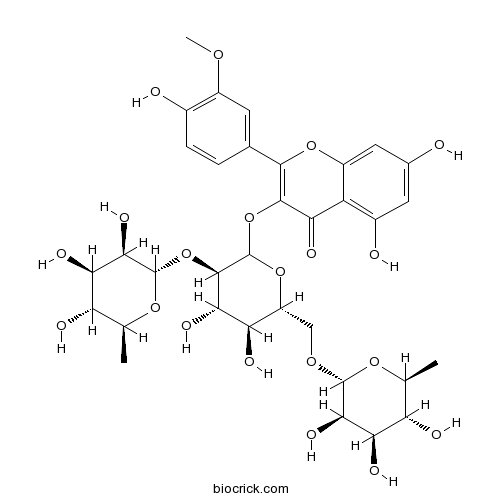Calendula officinalis
Calendula officinalis
1. The products in our compound library are selected from thousands of unique natural products; 2. It has the characteristics of diverse structure, diverse sources and wide coverage of activities; 3. Provide information on the activity of products from major journals, patents and research reports around the world, providing theoretical direction and research basis for further research and screening; 4. Free combination according to the type, source, target and disease of natural product; 5. The compound powder is placed in a covered tube and then discharged into a 10 x 10 cryostat; 6. Transport in ice pack or dry ice pack. Please store it at -20 °C as soon as possible after receiving the product, and use it as soon as possible after opening.
Natural products/compounds from Calendula officinalis
- Cat.No. Product Name CAS Number COA
-
BCN4994
Typhaneoside104472-68-6
Instructions

[Spectral Evidence of In-Situ Regulatory Mechanisms on Chemical Speciation of Lead/Cadmium Affected by Dissolved Organic Matter Extracted from Rhizosphere Loess of Calendula Officinalis Seedling].[Pubmed: 30084614]
The various characteristics of DOM have great impact on the transformation process of contaminants in soil due to the generation of the feedback regulation in cycles of plant, Rhizosphere soil and environmental contaminants. Currently, more attention was paid on contaminants behaviors of adsorption, transformation, accumulation and detoxification than DOM derived from Rhizosphere soil. The chemical speciation of lead/cadmium and growth efficiency related variations were revealed in the growth process of Calendula officinalis seedlings, and the spectral characteristics of DOM in Rhizosphere loess were discussed with UV, FT-IR and 3D-EEMs spectra. The results showed: the dominant contents of lead/cadmium are in residual and exchangeable speciation, and the exchangeable contents increase greatly after the growth of Calendula officinalis seedlings. It causes negative effects on the height and emergency rate of Calendula officinalis seedlings with lead/cadmium, and the Calendula officinalis is able to positively improve loess characteristics. The root of Calendula officinalis appears to be longer, thinner and flexuous. The maximum absorption band of DOM in UV spectra locates in 200~240 nm, and the sharper and greater intensity of peaks can be detected under lead/cadmium stress. The absorption peaks in FT-IR spectra move from 3 444 and 1 637 to 3 440 and 1 645 cm-1, respectively, indicating the combination effects between metal ions and functional groups of—OH and CO. The dominant fluorescence peaks of DOM are found to be aroundλex/em=240/430, described as fulvic-acid like components, and metals in loess affect more on peaks intensity than locations. The characteristics of DOM in Rhizosphere loess of Calendula officinalis seedlings contain much micro-eco-environmental information, and the spectral approaches are efficient to reveal the relationship between DOM and chemical speciation of lead/cadmium.
Screening of acute and sub-chronic dermal toxicity of Calendula officinalis L essential oil.[Pubmed: 30075180]
None
Traditional and ethnobotanical dermatology practices in Romania and other Eastern European countries.[Pubmed: 29908576]
The geographic and ecologic specificity of Romania and other Eastern European countries has resulted in the development of an exceptional diversity of medicinal plants. The purpose of this study was to provide an overview of the ethnobotanical dermatology practices based on the use of medicinal plants in this region. The indications, ethnopharmacologic activities, parts used, and administration of 106 medicinal plants are provided. We also discuss the relative importance of these species, using two modified indices of quantitative ethnobotany: Use Value Index and Relative Dermatologic Importance, which were calculated on the basis of etic constructions (indications and ethnopharmacologic activities). The species identified to have the highest dermatologic importance (on a scale of 100) were Brassica oleracea L. (100), Matricaria chamomilla L. (79.17), Arctium lappa L. (74.82), Daucus carota L. (72.28), Equisetum arvense L. (70.47), Juglans regia L. (69.93), Populous nigra L. (65.94), Symphytum officinale L. (63.59), Chelidonium majus L. (57.78), Calendula officinalis L. (57.78), Achillea millefolium L. (57.43), Melilotus officinalis L. (55.25), Allium cepa L. (51.45), Quercus robur L. (51.08), and Betula spp. (50.91). This preliminary study on ethnobotanical dermatology practices indicates that Eastern European traditional medical knowledge represents an important heritage that is currently underexploited.
Increased synthesis of a new oleanane-type saponin in hairy roots of marigold (Calendula officinalis) after treatment with jasmonic acid.[Pubmed: 29665737]
Native plant of marigold (Calendula officinalis L.) synthesizes oleanolic acid saponins classified as glucosides or glucuronides according to the first residue in sugar chain bound to C-3 hydroxyl group. Hairy root culture, obtained by transformation with Agrobacterium rhizogenes strain 15834, exhibit a potent ability of synthesis of oleanolic acid glycosides. The HPLC profile of saponin fraction obtained from C. officinalis hairy roots treated with plant stress hormone, jasmonic acid, showed the 10-times increase of the content of one particular compound, determined by NMR and MALDI TOF as a new bisdesmoside saponin, 3-O-β-d-glucuronopyranosyl-28-O-β-d-galactopyranosyl-oleanolic acid. Such a diglycoside does not occur in native C. officinalis plant. It is a glucuronide, whereas in the native plant glucuronides are mainly accumulated in flowers, while glucosides are the most abundant saponins in roots. Thus, our results revealed that the pathways of saponin biosynthesis, particularly reactions of glycosylation, are altered in C. officinalis hairy root culture.


